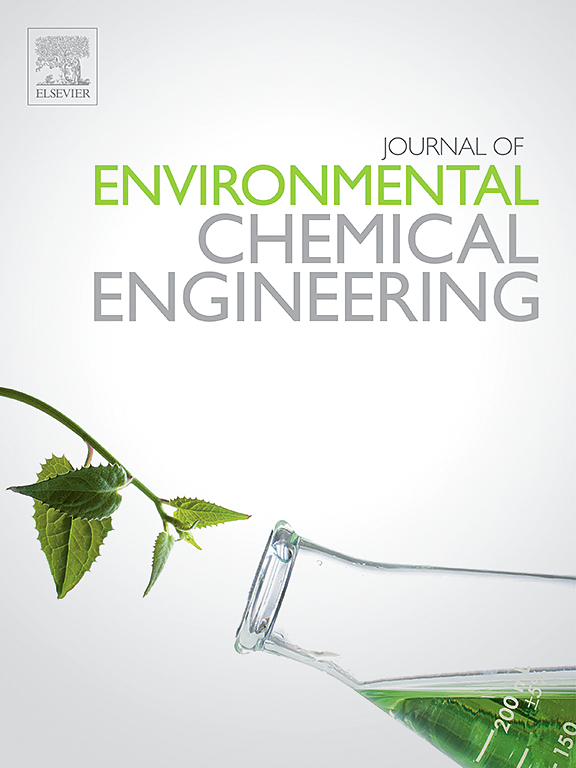Development of two-dimensional amyloid fibril/carboxymethyl cellulose hybrid membranes for effective adsorption of hexavalent chromium
IF 7.4
2区 工程技术
Q1 ENGINEERING, CHEMICAL
引用次数: 0
Abstract
Amyloid fibrils (AFs) are protein aggregates with highly ordered fibrillar structures and can be formed via self-assembly of proteins under appropriate conditions. Owing to the unique properties of AFs, e.g., high surface-to-volume ratio and versatile functional groups, they offer abundant binding sites for the efficient adsorption of hexavalent chromium (Cr(VI)). This study was aimed at examining the performance of two-dimensional AF-based hybrid membranes for adsorbing Cr(VI). First, AF/carboxymethyl cellulose (AF/CMC) hybrid membranes were synthesized via chemical crosslinking coupled with phase inversion, followed by investigating the synthesis mechanism using Fourier transform infrared spectroscopy. Our results revealed that the surface microstructures and mechanical properties of the hybrid membranes could be affected by the AF:CMC mass ratio of the membrane. The porosity and ζ-potential of hybrid membranes were found to be dependent on both pH value and membrane composition. Analyses of the kinetics and thermodynamic behavior of Cr(VI) adsorption on the AF/CMC hybrid membranes revealed that the initial adsorption rate and maximum adsorption capacity were determined to be ∼149.20 mg g–1 h–1 and ∼311.11 mg g–1, respectively. The Cr(VI) removal percentage of hybrid membrane with high CMC content was found to remain at >75 % after five successive adsorption-desorption cycles. Finally, the mechanism and interactions involved in the adsorption of Cr(VI) on the hybrid membrane were further investigated via thermodynamic analysis and X-ray photoelectron spectroscopy. This study provides an excellent example of harnessing AF-based membranes in water remediation, highlighting the potential of AF-based hybrid materials for wastewater treatment applications.
开发用于有效吸附六价铬的二维淀粉样纤维/羧甲基纤维素混合膜
淀粉样纤维(AFs)是具有高度有序纤维结构的蛋白质聚集体,可在适当条件下通过蛋白质自组装形成。由于淀粉样纤维的独特性质,如高表面体积比和多功能基团,它们为高效吸附六价铬(Cr(VI))提供了丰富的结合位点。本研究旨在考察基于二维 AF 的混合膜吸附六价铬的性能。首先,通过化学交联和相反转合成了 AF/ 羧甲基纤维素(AF/CMC)杂交膜,然后利用傅里叶变换红外光谱研究了合成机理。结果表明,杂化膜的表面微结构和力学性能受 AF:CMC 质量比的影响。混合膜的孔隙率和ζ电位与 pH 值和膜成分有关。对 AF/CMC 混合膜吸附六价铬的动力学和热力学行为分析表明,初始吸附速率和最大吸附容量分别为 ∼149.20 mg g-1 h-1 和 ∼311.11 mg g-1。高 CMC 含量的混合膜对六价铬的去除率在连续五次吸附-解吸循环后保持在 75%。最后,通过热力学分析和 X 射线光电子能谱进一步研究了混合膜吸附六价铬的机理和相互作用。这项研究提供了一个利用 AF 基膜进行水修复的绝佳实例,凸显了 AF 基混合材料在废水处理应用中的潜力。
本文章由计算机程序翻译,如有差异,请以英文原文为准。
求助全文
约1分钟内获得全文
求助全文
来源期刊

Journal of Environmental Chemical Engineering
Environmental Science-Pollution
CiteScore
11.40
自引率
6.50%
发文量
2017
审稿时长
27 days
期刊介绍:
The Journal of Environmental Chemical Engineering (JECE) serves as a platform for the dissemination of original and innovative research focusing on the advancement of environmentally-friendly, sustainable technologies. JECE emphasizes the transition towards a carbon-neutral circular economy and a self-sufficient bio-based economy. Topics covered include soil, water, wastewater, and air decontamination; pollution monitoring, prevention, and control; advanced analytics, sensors, impact and risk assessment methodologies in environmental chemical engineering; resource recovery (water, nutrients, materials, energy); industrial ecology; valorization of waste streams; waste management (including e-waste); climate-water-energy-food nexus; novel materials for environmental, chemical, and energy applications; sustainability and environmental safety; water digitalization, water data science, and machine learning; process integration and intensification; recent developments in green chemistry for synthesis, catalysis, and energy; and original research on contaminants of emerging concern, persistent chemicals, and priority substances, including microplastics, nanoplastics, nanomaterials, micropollutants, antimicrobial resistance genes, and emerging pathogens (viruses, bacteria, parasites) of environmental significance.
 求助内容:
求助内容: 应助结果提醒方式:
应助结果提醒方式:


